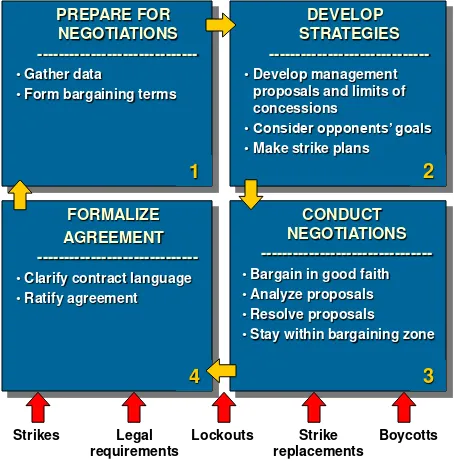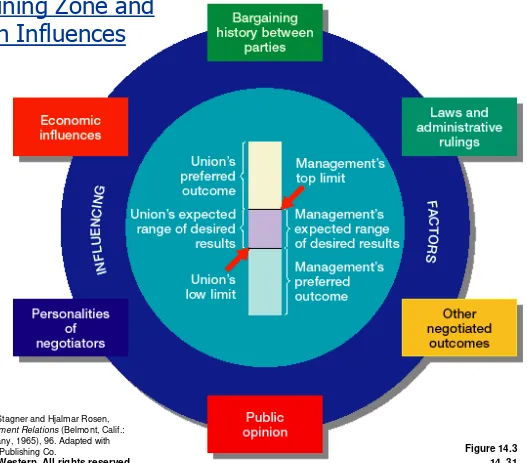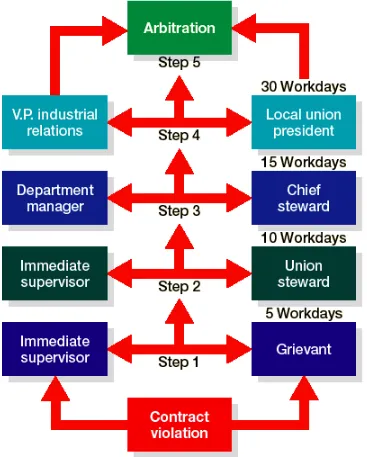Objectives
After studying this chapter, you should be able to:
1. Identify and explain the principal federal laws that provide the framework for labor relations.
2. Explain the reasons employees join unions.
3. Describe the process by which unions organize
employees and gain recognition as their bargaining agent.
Objectives (cont’d)
After studying this chapter, you should be able to:
5. Differentiate the forms of bargaining power that a union and an employer may utilize to enforce their bargaining demands.
6. Describe a typical union grievance procedure and explain the basis for arbitration awards.
Major Labor Laws
•
Railway Labor Act (RLA) of 1926
•
Norris LaGuardia Act (Anti-Injunction Act)
•
Wagner Act (National Labor Relations Act) of
1935
•
Taft-Harley Act (Labor-Management Relations
Act) of 1947
•
Landrum-Griffin Act (Labor-Management
Disclosure Act) of 1959
Government Regulation of Labor Relations
•
The Railway Labor Act (RLA) of 1926
Purpose of the act is to avoid service interruptions resulting from disputes between railroads and their operating unions.
National Mediation Board
National Railway Adjustment Board
•
The Norris-LaGuardia Act of 1932
Restricts the ability of employers to obtain an
Government Regulation of Labor Relations
•
The Wagner Act (National Labor Relations Act)
of 1935
Protects employee rights to organize and bargain collectively through representatives of their choice. Created the National Labor Relations Board (NLRB)
to govern labor relations in the United States.
Holds secret ballot union representation elections.
Wagner Act
•
Section 7 of the Act guarantees these rights:
To self-organization, to form, join, or assist labor organizations, to bargain collectively through freely chosen representatives.
To engage in concerted activities, for the purpose of collective bargaining or other mutual aid or protection.
To refrain from any or all of such activities except to the extent that such right may be affected by an
Unfair Labor Practices (ULPs)
•
Section 8 of the Wagner Act outlawed employer
practices that deny employees their rights and
benefits:
Interference with Section 7 rights
Domination of a union (company union)
Discrimination against union members Arbitrary discharge of union members
Refusal to bargain with the union
Amendments to the Wagner Act
•
The Taft-Hartley Act (The Labor-Management
Relations Act) of 1947
Balances the rights and duties of labor and
management in the collective bargaining arena by defining unfair union practices.
•
The Landrum-Griffin Act (Labor-Management
Reporting and Disclosure Act) of 1959
Unfair Union Practices
Interfering with Section 7 rights of employees
Interfering with representation elections
Influencing employers to discriminate with
regard to union membership
Refusal to bargain collectively with employer
Interference with certified employee
representative’s relationship with employer
Assessment of excessive initiation fees and
dues on bargaining unit members
Labor Relations Process
1.
Workers desire collective representation
2.
Union begins its organizing campaign
3.
Collective negotiations lead to a contract
The Labor Relations
Process
Why Employees Unionize
•
As a result of economic needs (wages and
benefits)
•
Dissatisfaction with managerial practices
•
To fulfill social and status needs.
•
Unionism is viewed as a way to achieve results
they cannot achieve acting individually
Organizing
Campaigns
Union/Employee ContactInitial Organizational Meeting
Formation of In-House Committee
Election Petition and Voting Preparation
Contract Negotiations
Steps in the Organizing
Aggressive Organizing Tactics
•
Political Involvement
•
Union Salting
•
Organizer Training
•
Corporate Campaigns
•
Information Technology
Union NOW!!
Employer Tactics Opposing Unionization
• Stressing favorable employer-employee relationship
experienced without a union.
• Emphasize current advantages in wages, benefits, or
working conditions the employees may enjoy
• Emphasize unfavorable aspects of unionism: strikes,
union dues, abuses of legal rights
• Use statistics to show that unions commit large numbers
of unfair labor practices.
• Initiate legal action when union members and leaders
How Employees Become Unionized
•
Bargaining Unit
A group of two or more employees who share
common employment interests and conditions and may reasonably be grouped together for purposes of collective bargaining.
•
Exclusive Representation
The legal right and responsibility of the union to represent all bargaining unit members equally,
The Labor Organization Process
Workers Seek Collective Representation
Union Begins The Organizing Process
Collective Bargaining For A Contract
Contract Administration
Management Labor
Impact of Unionization on Managers
•
Challenges to Management Prerogatives
Management prerogatives versus union participation in decision-making in the work place.
•
Loss of Supervisory Authority
Constraints on management in directing and
Union Structure and Governance
•
Craft Unions
•
Industrial Unions
•
Employee Associations
•
AFL-CIO
•
National Unions
•
Local Unions
Types of Unions
•
Craft unions
Unions that represent skilled craft workers
•
Industrial unions
Unions that represent all workers—skilled,
semiskilled, unskilled—employed along industry lines
•
Employee associations
Labor organizations that represent various groups of professional and white-collar employees in
Structure of the AFL-CIO
GENERAL BOARD
Executive members and principal officer of each international union affiliate
Meets upon call of federation president of executive council
Standing committees
Staff departments
Affiliated national and international unions
Local unions of national and international unions
Local unions affiliated directly with AFL-CIO
Affiliated state bodies
Local bodies
Structure and Functions of the AFL-CIO
• The “House of Labor”
Disseminates labor policy developed by leaders of affiliated unions.
Coordinates organizing activities among affiliated unions.
Provides research and other assistance through its various departments.
Lobbies before legislative bodies on labor subjects
Publicizes the concerns and benefits of unionization
Typical Organization of a Local Union
Local Union Meeting (Normally Monthly)
President
Business Representative
Various Committee Chairpersons
Vice-Presidents
Secretary/Treasurer
Sergeant at Arms
Training and Education
Grievance Committee: Chief Steward and
Shop Stewards
Collective Bargaining
Social
Local Union Members
Structure and Functions of Local Unions
•
Local Officers
Elected officials who lead the union and serve on the bargaining committee for a new contract.
•
Union Steward
An employee, as a nonpaid union official, represents the interests of members in their relations with
management.
•
Business Unionism
The term applied to the goals of U.S. labor
Types of Arbitration
•
Compulsory Binding Arbitration
A process for employees such as police officers, firefighters, and others in jobs where strikes cannot be tolerated to reach agreement.
•
Final-offer Arbitration
The arbitrator must select one or the other of the final offers submitted by the disputing parties with the
award is likely to go to the party whose final
The
Collective Bargaining Process
PREPARE FOR NEGOTIATIONS
---• Gather data
• Form bargaining terms
DEVELOP STRATEGIES
---• Develop management proposals and limits of concessions
• Consider opponents’ goals
• Make strike plans
CONDUCT NEGOTIATIONS
---• Bargain in good faith
• Analyze proposals
• Resolve proposals
• Stay within bargaining zone
FORMALIZE AGREEMENT
---• Clarify contract language
• Ratify agreement
1 2
The Bargaining Process
•
Collective Bargaining Process
The process of negotiating a labor agreement, including the use of economic pressures by both parties.
•
Bargaining Zone
Area within which the union and the employer are willing to concede when bargaining.
•
Interest-based Bargaining
Items In A Labor Agreement
•
Typical clauses will cover:
Wages
Vacations
Holidays
Work schedules
Management rights
Union security Transfers
Discipline
Grievance procedures
No strike/no lockout clause
Overtime
Safety procedures
Severance pay
Seniority
Pensions and benefits Outsourcing
Items In A Labor Agreement (cont’d)
•
Progressive
clauses will cover:
Employee access to records
Limitations on use of performance evaluation Elder care leave
Flexible medical spending accounts
Protection against hazards of technology equipment (VDTs)
Limitations against electronic monitoring Procedures governing drug testing
Management and Union Power
in Collective Bargaining
•
Bargaining Power
The power of labor and management to achieve their goals through economic, social, or political influence.
•
Union Bargaining Power
Strikes, pickets, and boycotts
•
Management Bargaining Power
Hiring replacement workers
Continuing operations staffed by management Locking out employees
Picketing
Striking
Union Power in Collective Bargaining
Boycotting
Boycott
Our
Employer
Employer Power in Collective Bargaining
Demanding concessions Locking out workers
Management methods for applying
economic pressure during bargaining:
Outsourcing normal work
Union Security Agreements
•
Dues Checkoff
Gives the employer the responsibility of withholding union dues from the paychecks of union members who agree to such a deduction.
•
“Shop” Agreements
Require employees to join or support the union. Union shop requires employee membership. Agency shop allows voluntary membership;
Five-Step
Grievance
Procedure
• Grievance Procedure
A formal procedure that provides for the union to represent members and nonmembers in
processing a grievance
Figure 14.4
Grievance Arbitration
•
Rights Arbitration
Arbitration over interpretation of the meaning of contract terms or employee work grievances.
•
Fair Representation Doctrine
The doctrine under which unions have a legal
Grievance (Rights) Arbitration
Submission agreement and awards Rights arbitration and EEO conflicts
Significant issues in using arbitration as a method for dispute resolution:
Deciding to use binding arbitration
Fair Representation Doctrine
The Arbitration Process
•
Arbitrator declares the hearing open and obtains
the
submission agreement
.
•
Parties present opening statements.
•
Each side presents its case using witnesses and
evidence; witnesses can be cross examined.
•
Parties make closing statements.
The Arbitration Decision
•
Four factors arbitrators use to decide cases:
The wording of the labor agreement (or employment policy in nonunion organizations).
The submission agreement (statement of problem to be solved) as presented to the arbitrator.
Testimony and evidence offered during the hearing.
Arbitration criteria or standards (similar to standards of common law) against which cases are judged.
Current Challenges to Unions
Employers’ focus on
maintaining nonunion status
Important issues confronting unions
Foreign competition and technological change



